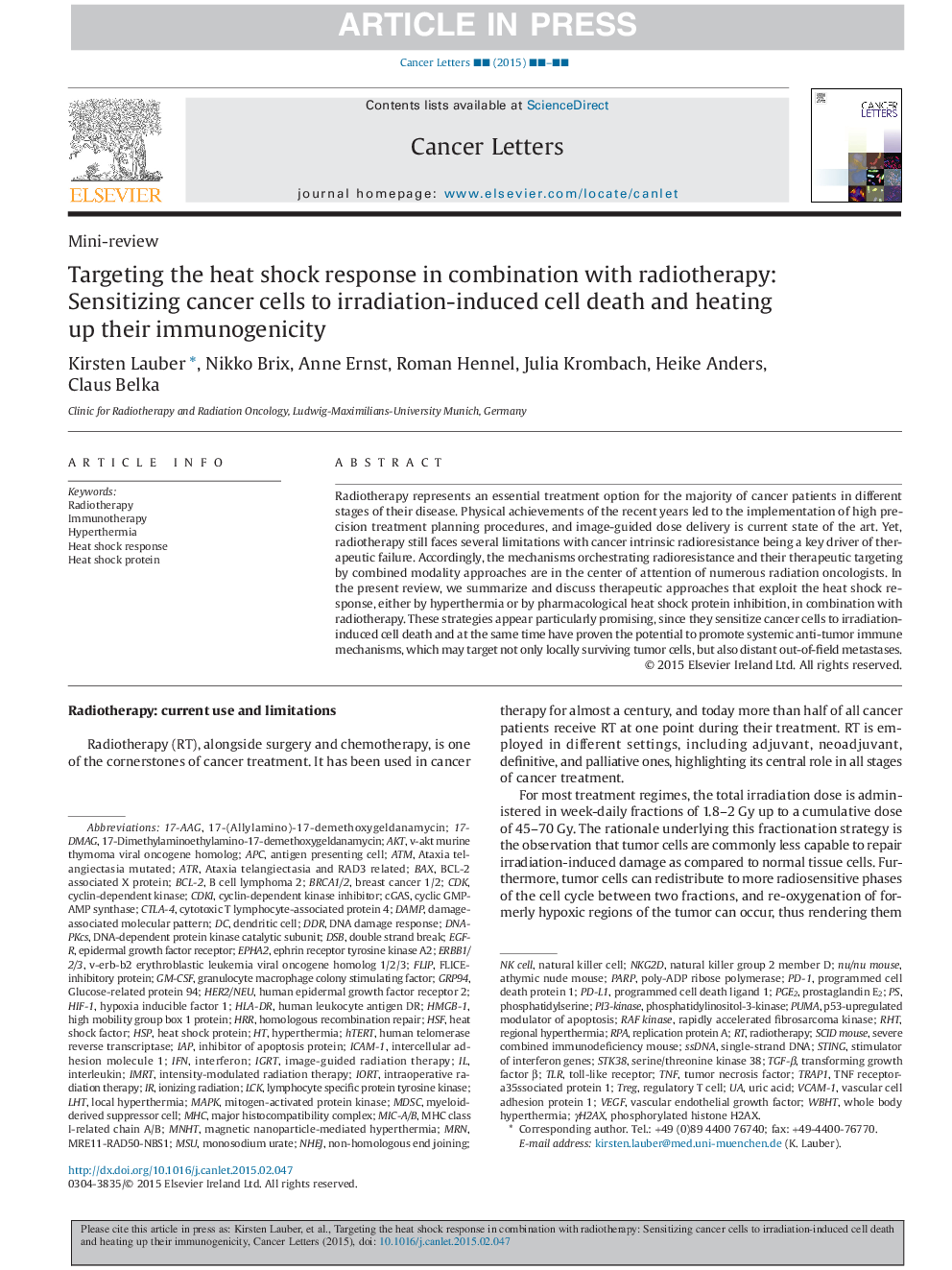| Article ID | Journal | Published Year | Pages | File Type |
|---|---|---|---|---|
| 10899407 | Cancer Letters | 2015 | 21 Pages |
Abstract
Radiotherapy represents an essential treatment option for the majority of cancer patients in different stages of their disease. Physical achievements of the recent years led to the implementation of high precision treatment planning procedures, and image-guided dose delivery is current state of the art. Yet, radiotherapy still faces several limitations with cancer intrinsic radioresistance being a key driver of therapeutic failure. Accordingly, the mechanisms orchestrating radioresistance and their therapeutic targeting by combined modality approaches are in the center of attention of numerous radiation oncologists. In the present review, we summarize and discuss therapeutic approaches that exploit the heat shock response, either by hyperthermia or by pharmacological heat shock protein inhibition, in combination with radiotherapy. These strategies appear particularly promising, since they sensitize cancer cells to irradiation-induced cell death and at the same time have proven the potential to promote systemic anti-tumor immune mechanisms, which may target not only locally surviving tumor cells, but also distant out-of-field metastases.
Keywords
CDKDSBIMRTPD-1CgasHRRATRDDRPD-L1HIF-1DAMPICAM-1NHEJBcl-2PGE2HspAPCTLRIAPRHT17-AAGGM-CSFPARPMRNhsfHLA-DRTregEGF-RVCAM-1FLIPHMGB-1γH2AXEphA2GRP94ssDNARPALCKNKG2DMDSCnatural killer group 2 member DCDKIp53-upregulated modulator of apoptosisDNA-PKcsMSUcyclic GMP-AMP synthaseSTK38Mre11-Rad50-Nbs1PI3-kinaseIORTTRAP1LHTSevere combined immunodeficiency mouseTNFTGF-βCTLA-4FLICE-inhibitory proteinIGRT17-(allylamino)-17-demethoxygeldanamycin17-DMAGataxia telangiectasia mutatedataxia telangiectasia and Rad3 relatedBRCA1/2Single-strand DNAhTERTMAPKv-akt murine thymoma viral oncogene homologAktUric aciddamage-associated molecular patternimmunotherapyinterferonIFNinterleukinHER2/neuBaxionizing radiationTransforming growth factor βHomologous recombination repairreplication protein Ahuman telomerase reverse transcriptaseToll-like receptorATMRadiotherapyRaf kinaseNK cellRegulatory T cellDendritic cellNatural killer cellmyeloid-derived suppressor cellantigen presenting celldouble strand breakhypoxia inducible factor 1Granulocyte macrophage colony stimulating factorheat shock factornon-homologous end joiningVascular endothelial growth factorVascular Endothelial Growth Factor (VEGF)tumor necrosis factorPhosphatidylserinephosphatidylinositol-3-kinaseB cell lymphoma 2programmed cell death ligand 1MHCmajor histocompatibility complexstimulator of interferon genesinhibitor of apoptosis proteincyclin-dependent kinase inhibitorSCID mouseIntercellular adhesion molecule 1Monosodium urateSTINGphosphorylated histone H2AXHyperthermiaWhole body hyperthermiaLocal hyperthermiaRegional hyperthermiaDNA-dependent protein kinase catalytic subunitDNA damage responseHeat shock responseimage-guided radiation therapyIntraoperative radiation therapyintensity-modulated radiation therapyBcl-2 Associated X proteinHigh mobility group box 1 proteinHeat shock proteinprogrammed cell death protein 1vascular cell adhesion protein 1mitogen-activated protein kinaseProstaglandin E2poly-ADP ribose polymerasePUMAcyclin-dependent kinaseHuman epidermal growth factor receptor 2Epidermal growth factor receptor
Related Topics
Life Sciences
Biochemistry, Genetics and Molecular Biology
Cancer Research
Authors
Kirsten Lauber, Nikko Brix, Anne Ernst, Roman Hennel, Julia Krombach, Heike Anders, Claus Belka,
